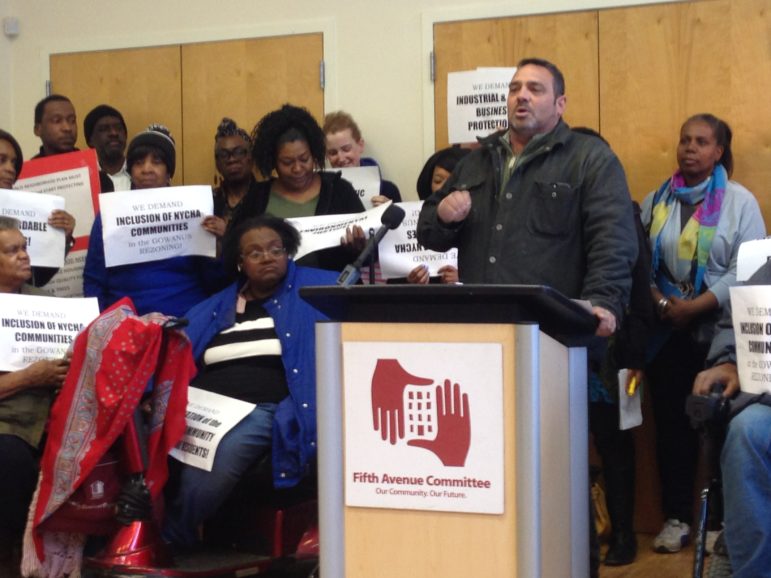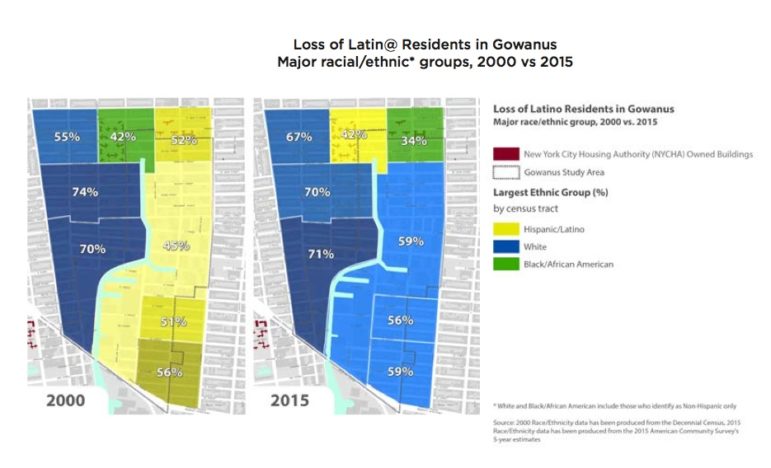
Abigail Savitch-Lew
Gowanus Alliance’s Paul Basile speaks at Wednesday’s event.
A coalition of Gowanus stakeholders is demanding that any rezoning of Gowanus benefit longtime residents and be attentive to matters of racial and economic equity.
The newly formed Gowanus Neighborhood Coalition for Justice, which includes the Fifth Avenue Committee, Families United for Racial and Economic Equality (FUREE), five organizations associated with local NYCHA developments, the Gowanus Alliance, the Gowanus Canal Conservancy, local churches and other groups, released a report Tuesday documenting the racial and economic transformation of the Gowanus area since 2000.
That report, which can be viewed in full here, argues that the neighborhood’s change can be linked to the 2003 and 2007 rezonings of Fourth Avenue and Park Slope and their failure to include measures to prevent displacement, or to ensure benefits accrued to low-income renters and people of color.
The report describes demographic changes in an area bordered by Fourth Avenue to the east, Court Street to the west, the Gowanus Expressway to the south and Bergen Street to the north. It finds that while the median income of this area increased by 162 percent between 2000 and 2015, not everyone benefited equally from the growth, with widening income inequality between the lowest- and highest-income census tracts. The area saw a 10 percent decrease in Latino residents, a 4 percent decrease in Black residents, and an 11 percent increase in White residents, such that White residents became the majority in all but two census tracts.
These changes took place as the neighborhood lost a significant share of its rent-stabilized housing stock. In one instance, a landlord harassed the tenants of five rent-stabilized buildings, displacing 40 households in order to make way for a luxury apartment building at the larger size permitted under the new zoning. From 2007 to 2014, Gowanus, Park Slope and Carroll Gardens saw a 22 percent decrease in rent-stabilized units, while citywide there was only a 6 percent decrease.
But the coalition argues that displacement is not the only problem; its members say changes to the neighborhood have not lead to the sufficient integration of communities and schools, with low-income residents of color feeling shut out of new opportunities. According to the report, although School District 15 (encompassing Red Hook, Gowanus, Park Slope, Carroll Gardens and Sunset Park) is 28 percent White, 50 percent of white students attend just three selective middle schools.
on the Gowanus Rezoning
The coalition, organized by the Fifth Avenue Committee, seeks to build upon the contributions of Bridging Gowanus, a community-planning process initiated by Council member Brad Lander in 2013 that set the stage for a potential rezoning of the area. Well-recognized organizations like the Fifth Avenue Committee, the Gowanus Canal Conservancy, the Gowanus Alliance and a limited number of public housing residents were also involved in that earlier process.
“While Bridging Gowanus ambitiously sought out to understand and document the spectrum of opinions and needs of the various stakeholders and communities living in the neighborhood, some key constituencies were largely under-represented in the process, most notably low- and moderate-income residents, the majority of whom are Latino and African-American,” the coalition’s report explains, adding that the coalition will now seek to craft recommendations that will take into account the most vulnerable people in Gowanus.
Any future rezoning, the coalition says, must take into account the voices of populations that have been historically marginalized by past land-use changes. The coalition also released a platform of priorities that will form the basis for a detailed list of recommendations to the Department of City Planning.
“It is one of the clearest examples of institutionalized oppression when you have all these thriving communities popping up around us and there’s not space for us affordability-wise or access-wise,” said local artist Imani Gayle of Gowanus Houses at a press conference on Tuesday. “We are just as excited about this growth, but we want inclusion and access to this growth.”
The priority list tackles both ends of the affordability crisis: demanding more deeply affordable housing, the passage of anti-displacement legislation and the preservation of existing affordable stores, as well as investments in workforce training and land use policies that will not only preserve but also grow Gowanus’s industrial sector.
Despite the demographic change of the past 15 years, the coalition disputes the idea that Gowanus is now a neighborhood that has already been completely gentrified without any remaining residents who could still be vulnerable to displacement during a rezoning. It’s true that today only eight percent of households in Gowanus live in rent-stabilized housing stock. But the coalition contends that the 25 percent of Gowanus’s population who live in public housing are also vulnerable.
“Although as a result of the rezoning there may not be direct displacement…there can be a sense of cultural displacement,” said Fifth Avenue Committee director Michelle de la Uz. “But also, if there’s not investment to preserve that much-needed public housing, then it could deteriorate to the point where it has to be vacated.”
To that end, many issues in the platform address matters of cultural displacement, segregation, discrimination, and conditions in public housing.
The coalition is concerned that a rise in high-income residents in the area will cause changes in policing, leading to racial profiling and abuse. It also wants to ensure equal access to schools—and to extracurricular opportunities within schools—and to new parks created during the restoration of the canal. And it calls for support for local artists who may not make their living as artists or be widely recognized, and support for institutions that are culturally relevant to Gowanus’s diverse community.
In addition, the coalition asks that environmental and resiliency initiatives take into account legacies of environmental injustice, such as the hardship of Gowanus Houses residents, who went 10 days without electricity or heat after Hurricane Sandy.
“We don’t want to see the separation of public housing from the rezoning process,” said Monica Underwood of Wyckoff Garden Residents Watch and FUREE. “How can you allow luxury developments when thousands of public housing residents are living in substandard conditions?”










5 thoughts on “Gowanus Groups Unite to Highlight Hopes and Fears Around Proposed Rezoning”
DeBlasio has given Gowanus a taste of what is in store for under his rezoning. All you have to do is look at Lightstone which has been and will be a major imposition on the community. And what has the community got in return: a hand full of affordable units along with some of the highest market rate rents in the city, which have hit other local renters with big rent hikes. Lightstone won’t even pay taxes for several decades, leaving the tax burdens on all other local property owners, helping drive up those other rents in the area.
This is a perfect study. The Gowanus Houses will no longer exist one day. Rent stabilized apartments are disappearing rapidly. Can’t they just leave some of Brooklyn alone? I’m in Sunset Park, next up for rezoning and displacement. With trinkets and beads for the displaced. For example, the new box stores hardly employ residents of my neighborhood. They’re from other boros. I asked quite a few. The few apartments offered for low income folks won’t cut it. The smaller two family homes are all being gutted and C of Os being changed to 3 family with high rents. The entire fabric of our community is at risk.
Sunset Park was re-zoned in two measures(South Slope/Greenwood Heights & then Sunset Park from 25th Street south) a few years back. They were in all the newspapers.
The CPD doesn’t like makeovers so soon after; however, Industry City is overdue on their a waterfront re-zoning proposal.
The Coalition of the Rockaways and I stand with Gowanus Houses. The Rockaways wants development but with infrastructure: We want better transportation, waste management plants, schools, hospitals … and to be represented by people from the neighborhood. Let me explain: This plan is not about affordable housing; this plan is for the greedy developers. In the future they will leave the program with corruption and bad representation. This pla,n which is a done deal, should be investigated by the Department of Justice. Why is the city warehousing apartments in city housing and Mitchell Lama buildings trying to go private if they cared? We the people of Far Rockaway want SBS bus service and use of the ferry for the people of Rockaway. Another issue is $91 million is not enough because buildings alone cost more. Neighborhoods of Color are always affected by this corruption. Like I said this plan smells but mark my words: they will pass it. Again, Department of Justice should investigate.
The coalition will fight to help the Rockaways. We will try to keep them honest. The coalition wants people to come out to the Bayswater Jewish Center to speak out against this plan on March 29 at 6:30 p.m.
Everyone must read this new book! “Zoned Out”
http://www.urpub.org/books/zonedout
Zoned Out! Race, Displacement, and City Planning in New York City
20.00 Editors: Tom Angotti and Sylvia Morse
Contributors: Tom Angotti; Philip DePaolo; Peter Marcuse; Sylvia Morse; Samuel Stein
It is critical to read up on Zoning Laws in NYC if one wants to fight the powers that be!